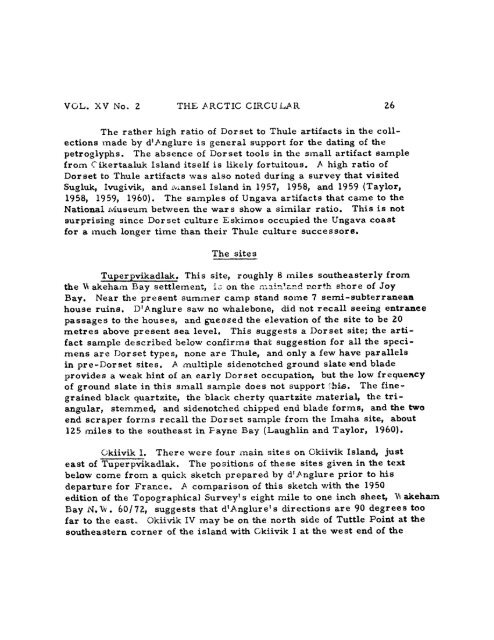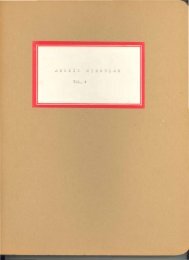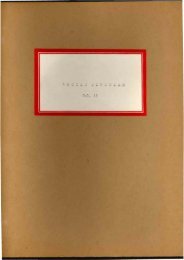A RCTIC CIRCULA NO. I Notes on a trip in l6-foot ... - The Arctic Circle
A RCTIC CIRCULA NO. I Notes on a trip in l6-foot ... - The Arctic Circle
A RCTIC CIRCULA NO. I Notes on a trip in l6-foot ... - The Arctic Circle
Create successful ePaper yourself
Turn your PDF publications into a flip-book with our unique Google optimized e-Paper software.
VGL. XV No" 2 THE A<str<strong>on</strong>g>RCTIC</str<strong>on</strong>g> <str<strong>on</strong>g>CIRCULA</str<strong>on</strong>g>IT z6<br />
<strong>The</strong> rather high ratio of Dorset to Thule artifacts <strong>in</strong> the collecti<strong>on</strong>e<br />
made by dt.A.nglure is general support for the dat<strong>in</strong>g of the<br />
petrogtyphs. <strong>The</strong> absence of Dorset tools <strong>in</strong> the small artifact eample<br />
fro<strong>in</strong> Cikertaaluk Island itself is likely forhritous. A high ratio of<br />
Dorset to Thule artifacts was also noted dur<strong>in</strong>g a survey that visited<br />
Sugluk, Ivugivik, and rv, ansel Island <strong>in</strong> L957, 1958, and 1959 (Taylort<br />
1958, 1959, 1960), <strong>The</strong> samples of Ungava artifacts that came to the<br />
Natioaal viugeurn between tJre wars show a similar ratio. This is not<br />
surpris<strong>in</strong>g s<strong>in</strong>ce Dorset culture Eskimoe occupied the Ungava coagt<br />
for a much l<strong>on</strong>ger tirne than their Thule culhrre successor6.<br />
<strong>The</strong> site s<br />
Tuperpvilajllak. This site, roughly 8 miles southeasterly frorn<br />
tbe \4 akeharn Bay settlernent, i; <strong>on</strong> the n::i-Land n"crth sh.ore of Joy<br />
Bay. Near tJre pregent surnrTrer camp stand some ? semi-subterranean<br />
house ru<strong>in</strong>s. DrAnglure saw no whaleb<strong>on</strong>e, did not recall eee<strong>in</strong>g eatranee<br />
passages to the houses, and guessed the elevati<strong>on</strong> of the site to be 20<br />
metres above present aea level. This suggests a Dorset eite; the artifact<br />
sample described below c<strong>on</strong>firms that suggesti<strong>on</strong> for all the specimens<br />
are llorset types, n<strong>on</strong>e are Thule, and <strong>on</strong>ly a few have parallels<br />
<strong>in</strong> pre-Dorset sites, A. rnuliiple sidenotched ground slate end blade<br />
provides a weak h<strong>in</strong>t of an early Dorset occupati<strong>on</strong>, but the low frequency<br />
of ground slate <strong>in</strong> this srnall sample does not support i:!ri.,s. <strong>The</strong> f<strong>in</strong>egra<strong>in</strong>ed<br />
black quartzite, the black cherty quartzite rnaterialr tJre triangular,<br />
stemmed, and sidenotched chipped end blade forms, and the two<br />
end scraper forms recall the Dorset sarnple from the Imaha siter about<br />
l25 miles to the southeast <strong>in</strong> Fayne Bay (Laughl<strong>in</strong> and Taylor' 1960).<br />
C,kiivik I, <strong>The</strong>re were four ma<strong>in</strong> sites <strong>on</strong> Ckiivik Island, just<br />
east of Tffifrkadlak. <strong>The</strong> positi<strong>on</strong>s of these sites given <strong>in</strong> the text<br />
below corne from a quick sketch prepared by drAnglure prior to his<br />
deparhrre for France. A comparis<strong>on</strong> of this sketch vrith tlre 1950<br />
editi<strong>on</strong> of the Topographical Surveyts eight mile to <strong>on</strong>e <strong>in</strong>ch sheet, Vr akeham<br />
Bay N.lv. 60 l7Z, suggests that drAnglurers directi<strong>on</strong>s are 90 degrees too<br />
far to the east. Okiivik IV may be <strong>on</strong> tJre nortJr side of Tuttle Po<strong>in</strong>t at the<br />
southeastern corner of the island with Ckiivik I at the west end of the












